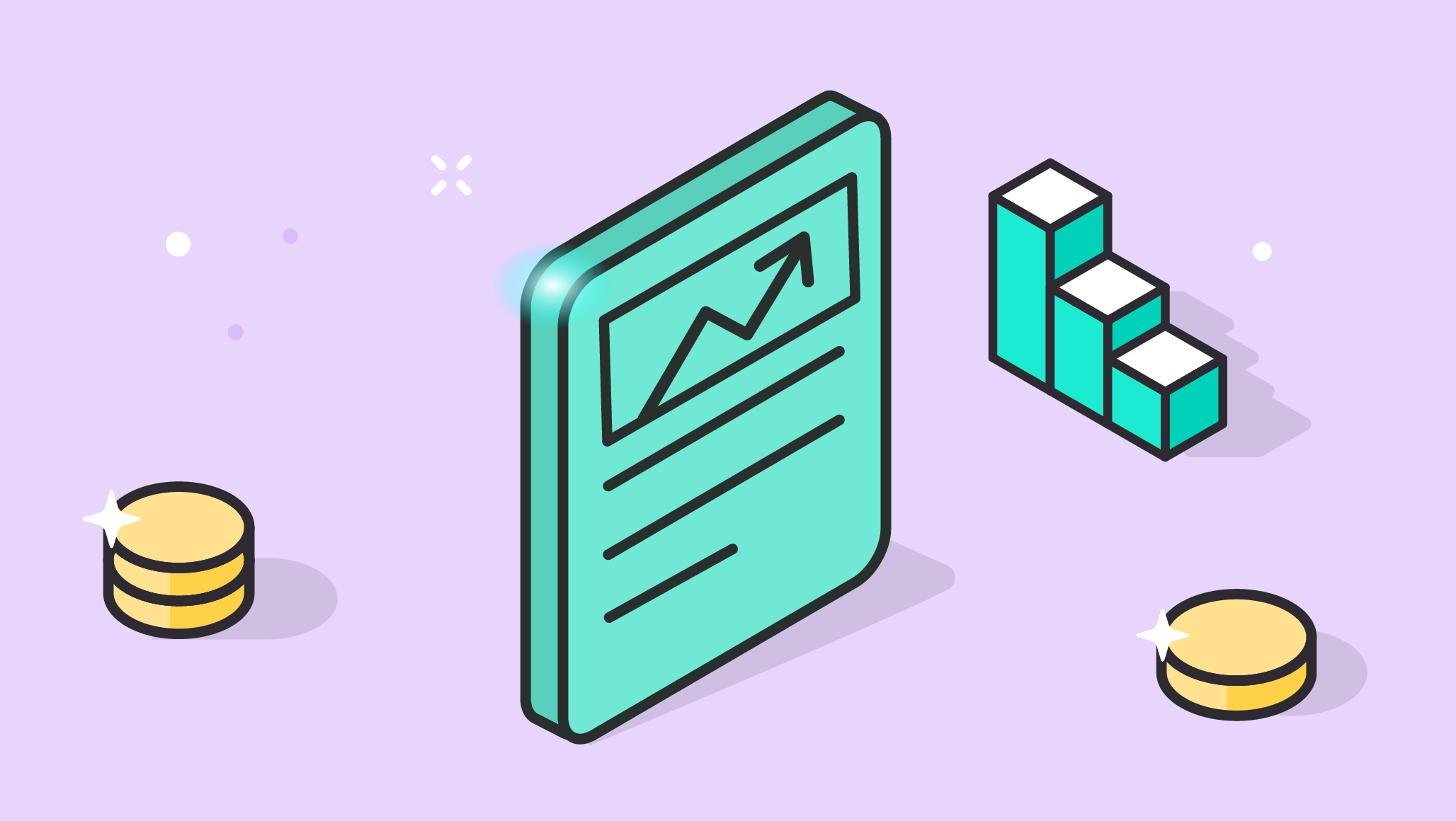- Share.Market
- 10 min read
- 02 Apr 2025
If there’s one thing an Indian household never runs out of, it’s two things – paranthas and gold.
From Dadi’s hidden locker stash to the great Indian wedding extravaganza, gold is not just an investment; it’s an emotion.
But with gold prices hitting record highs, some people are wondering, “Has gold already peaked?” While some believe it’s time to cash out and book that Goa trip, investors are asking – “Is this the right time to buy, or am I walking into a FOMO trap?”
In this piece, we’re going to deep dive into what’s driving gold’s rally, whether it’s still a good investment, and what investors can look for.
So, let’s break it down – keeping it simple and easy to grasp.
Gold: More Than Just a Shiny Metal
Gold isn’t just a metal; it’s a status symbol – especially in India.
Whether it’s in wedding jewelry, religious traditions, or family heirlooms, gold has always held a special place in our hearts (and lockers!).
But what makes gold so valuable?
Apart from its scarcity and durability, gold has been used as money for centuries.
It’s one of the few assets that has retained its value over time, making it a safe-haven investment during economic uncertainty.
Understanding Gold Purity: What Are Carats?
When buying gold, you’ll often hear about 24-carat, 22-carat, and 18-carat gold. So, what’s the deal?
- 24-carat (99.9% pure): The purest form, soft and best for investment (bars, coins).
- 22-carat (91.6% gold): Stronger, mixed with copper or silver, and used mostly in jewelry.
- 18-carat (75% gold): Durable, affordable, and popular in designer pieces.
Now that we know the basics, let’s dive into why gold prices are heating up.
Why Is Gold Heating Up?
We’ve identified four major reasons. Let’s decode them one by one:
Global Economic Uncertainty
Gold is a safe-haven asset, which means when economies wobble, investors rush towards gold to protect their wealth.
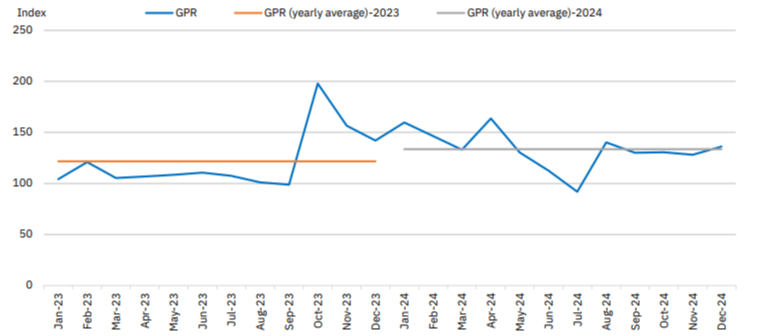
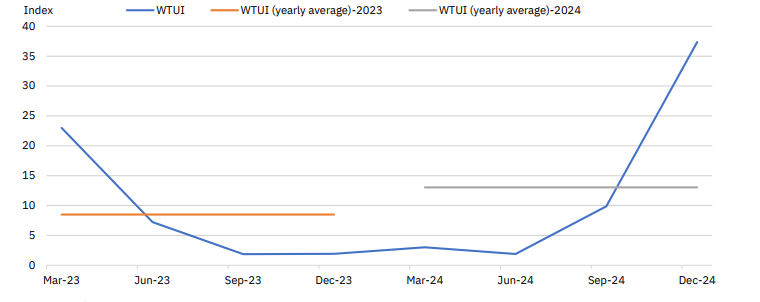
The above graph shows geopolitical risk and trade uncertainty because wars and trade tensions have risen significantly.
With ongoing concerns over global recession, geopolitical tensions, and economic instability, investors are parking their money in gold.
If we look at India specifically, the 24-carat gold rate at the end of March 2025 has touched ₹90,000 for 10 gm, marking a 32% increase on FY25. That’s not just a rise – it’s gold on steroids!
The data shows how gold prices in INR per gram have skyrocketed to ₹8,441, marking the sharpest jump in recent years.
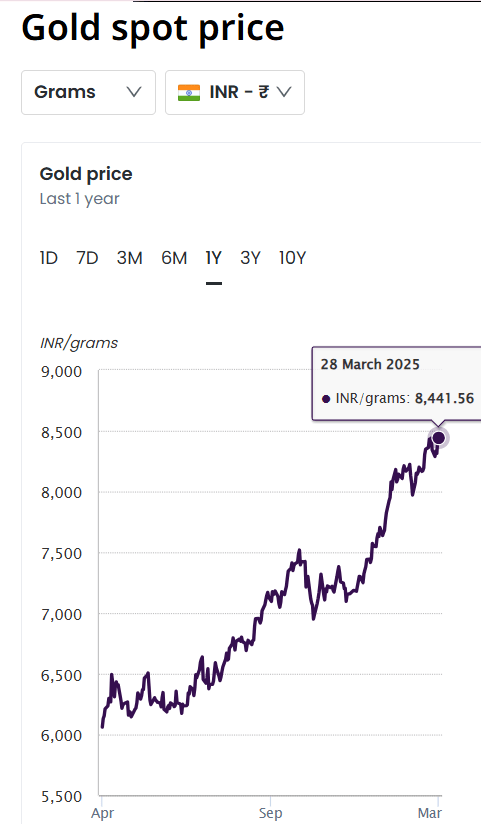
Central Banks Buying Gold
Countries are hoarding gold like never before.
Central banks, especially in China and India, have been aggressively increasing their gold reserves. More demand means higher prices.

In February, the RBI decided to take a breather from buying gold, marking its second pause in three months.
RBI’s gold buying over the months

But here’s the twist: since the start of 2024, the RBI has been on a gold-buying spree, adding an average of 6.3 tonnes every month over 12 of the last 14 months.
As of February, the RBI’s gold reserves stayed steady at 879 tonnes, but what’s interesting is that gold now makes up 11.5% of its total forex reserves – the highest it’s ever been and almost 4% higher than last year.
Looks like the RBI is doubling down on diversifying its reserves!
Inflation & Interest Rates
You’ve probably heard that gold prices go up when inflation is high – but what if we told you they can also rise when inflation goes down?
Sounds confusing? Don’t worry, let’s simplify it.
Inflation is Cooling Down – As of February 2025, inflation in India has dropped to 3.61%, mainly because food prices (like vegetables) are falling.
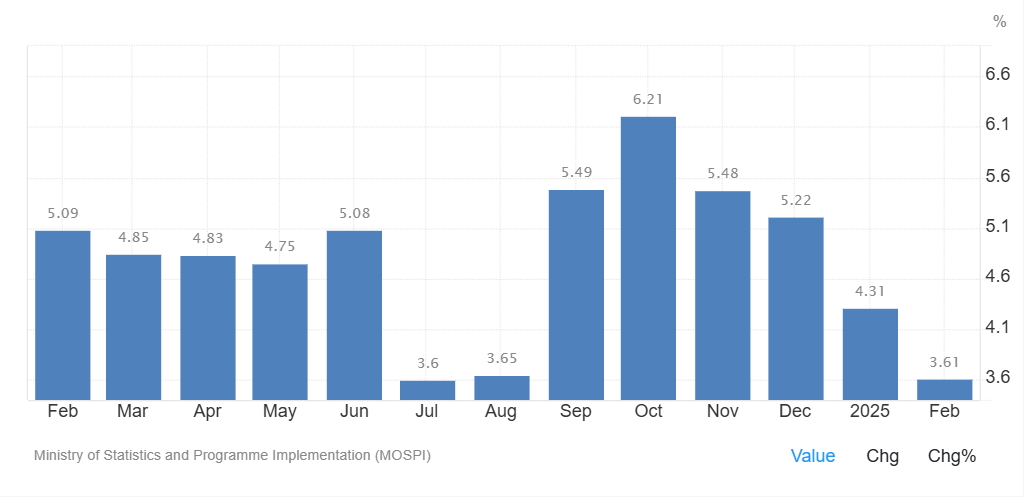
This means the cost of living isn’t rising as fast, which sounds like good news, right?
With inflation cooling down, there’s growing speculation that the RBI might cut interest rates soon to boost borrowing and spending. If the RBI lowers rates, it could have a ripple effect on investments.
And this is where gold comes into play.
When interest rates drop, fixed deposits and bonds start offering lower returns. This pushes some investors to look for better alternatives, and gold often benefits from this shift.
At the same time, gold doesn’t pay interest or dividends, so when safer investments (like FDs) become less rewarding, gold becomes relatively more attractive.
If more investors turn to gold, higher demand could push prices up – but remember, global factors like US Fed policy, inflation expectations, and central bank purchases also play a crucial role.
Stronger Dollar & Weaker Rupee
As of early April 2025, the rupee has fallen past ₹87 per USD, making imports, including gold, more expensive.

This depreciation is largely driven by the U.S. Federal Reserve’s tight monetary policy, which has strengthened the dollar and led to capital outflows from emerging markets like India.
Since gold is globally priced in U.S. dollars, a weaker rupee directly pushes up its price in India.
Additionally, with inflation concerns and market uncertainty, investors are turning to gold as a safe-haven asset, further increasing demand and driving prices higher.
If these currency and market trends persist, gold prices may continue their upward trajectory.
Now, before you start thinking, “Data after data, reason after reason,” let’s cut to the chase – is gold a better investment than equities?
Is Gold Better than Equities?
When it comes to investing, one key question always stands out: Which asset gives the best returns over time?
Let’s break down the performance of major asset classes in India to see what lessons you as investors can take away.
Returns Over Time
The recent data provides some key insights into how these assets have performed over different timeframes.
To illustrate, we’ve considered different investment categories, including:
- LBMA Gold PM & MCX Gold (gold benchmarks)
- S&P BSE Sensex (Indian equities), MSCI Emerging Markets (global equities) and
- CRISIL CB & BBG 1- 3Y Indian Tsy (bonds & fixed income).
At three different periods:
- YTD (Year-to-Date) – From January 2025 to March 28, 2025
- 10-Year CAGR (Compound Annual Growth Rate) – Returns over the last 10 years
- 20-Year CAGR – Returns over the last 20 years

Short-Term (YTD 2025) – Gold Shines Brightest:
In the short run, gold is clearly the star of the show, with returns of over 16%
No one else even comes close – stocks (Sensex, MSCI Emerging Markets) and bonds are lagging behind with much lower returns. Even commodities are nowhere near gold’s shine.
Medium-Term Performance (10-Year CAGR):
Looking at the 10-year returns, the scene is a bit more balanced:
Gold has performed well, but it’s not the top performer over this period. Sensex (Indian equities) outperforms gold, giving higher returns over the last decade.
Emerging Markets (MSCI EM) have done decently too, indicating that equities have been strong wealth generators.
Bonds (CRISIL CB, BBG 1- 3Y Indian Tsy) have been reliable but haven’t given much growth. Commodities have mostly underperformed.
Long-Term Performance (20-Year CAGR):
Now, this is where things get really interesting. Over 20 years:
Sensex emerges as the top performer, outshining both gold and bonds in terms of long-term returns.
Gold still provides solid growth, and it’s done particularly well as a hedge against inflation and market downturns.
Bonds have shown low but stable returns. Commodities, aside from gold, have performed the worst over this long period.
Now, you have a solid understanding of how different asset classes have performed over the years. But making investment decisions based only on returns is like carrying a glass half-full of water – it looks good, but the moment you move, it spills!
To truly make informed decisions, we need to go one level deeper. Understanding the volatility of these assets will give you a clearer, more stable grip on your investments.
Volatility
All assets move in cycles – no exceptions.
Gold, despite being a proven store of value and a strong performer, is no different. It’s a solid portfolio addition, but even the best-performing assets go through phases of booms and busts.
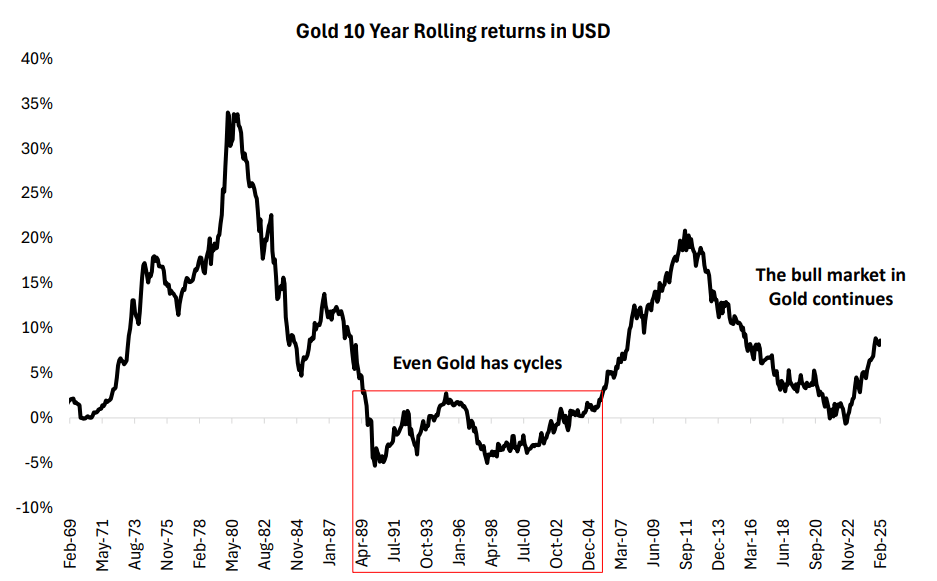
Gold has outpaced most equity markets in local currency terms in the 21st century.
But if you zoom in on Gold’s 10-year rolling returns in USD, you’ll see stretches of underperformance mixed with phases of exceptional gains.
A prime example?
In the years following COVID-19, massive government borrowing created a high margin of safety for Gold bulls, and they capitalized on it.
But let’s be real – Gold, like any other asset, isn’t a one-way street.
It has its ups and downs, just like stocks, bonds, or even real estate.
And that’s where things get interesting.
It’s not about choosing one asset over another but understanding how different assets move through cycles. Some assets shine in bull markets, while others provide stability when things get rough.
So, after diving deep into the numbers, charts, and history, here’s the million-dollar question – What’s the best bet for long-term wealth?
What Should an Investor Do?
Well, if investing were a one-size-fits-all game, life would be easy.
But markets don’t work that way!
Sometimes gold shines, sometimes stocks rule, and sometimes a balanced approach wins.
Here’s what the data say:
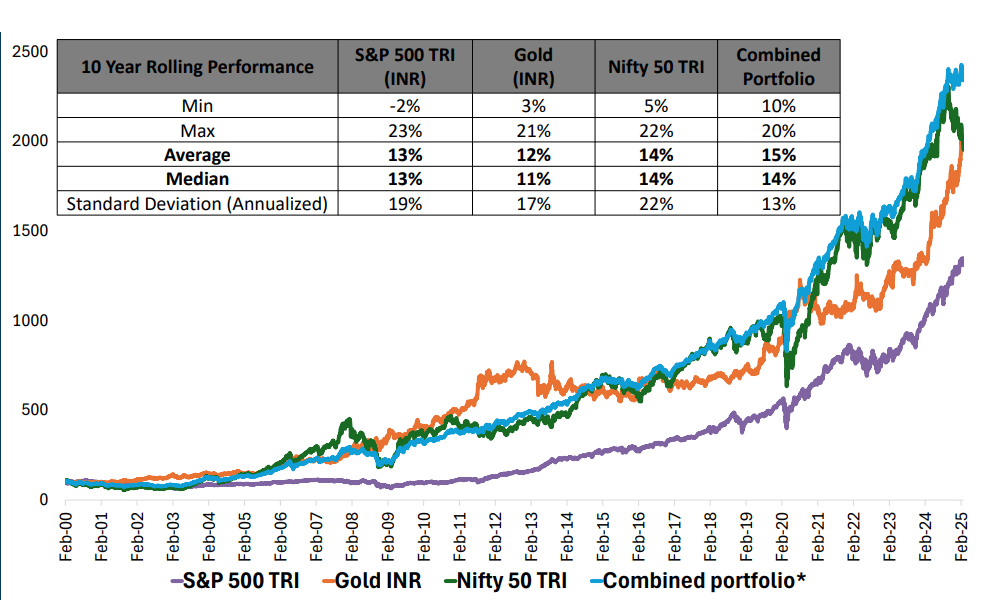
Nifty 50 had the highest average return (14%) in 25 years (2000 to 2025) but also the highest risk (22%).
That means it was the best wealth creator, but with a lot of ups and downs.
Gold had the lowest average return (12%) but acted as a steady performer (17% risk). This proves its role as a defensive asset rather than a high-growth one.
But here’s where the magic happens – the Combined Portfolio (a mix of stocks and gold) outshines all the individual assets, delivering an impressive average return of 15% with the lowest risk at just 13%.
It’s like getting the best of both worlds – strong returns without the wild rollercoaster ride!
So, Gold or Not?
Gold has its own special place in any portfolio, but putting all your eggs in one golden basket? Maybe not the best idea.
For long-term wealth, stocks could be your best buddy, but when things go south, gold steps up like a safety net.
So, should you buy gold now? Well, that’s up to you.
If you’re just jumping in because gold is shining bright, maybe take a step back and rethink.
Intelligent investors don’t just chase shiny things – they know when it makes sense to make a move.
We care that your shot lands in the right spot – it’s your game to play now.
